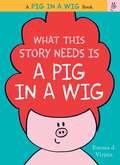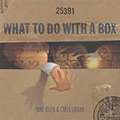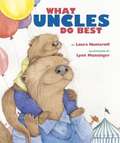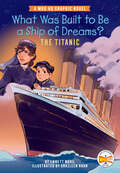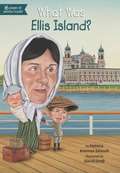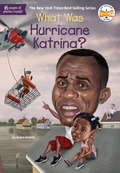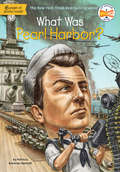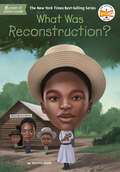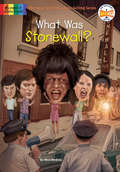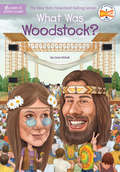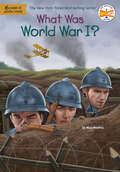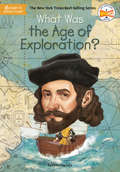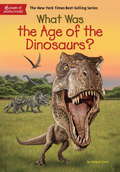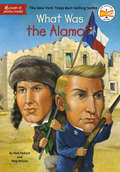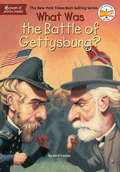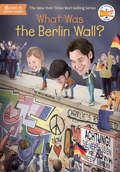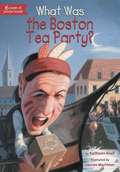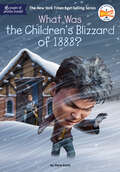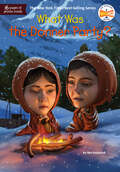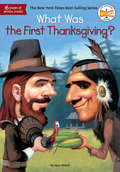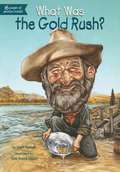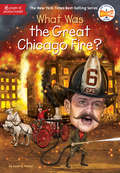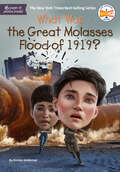- Table View
- List View
What This Story Needs Is a Pig in a Wig (A Pig in a Wig Book)
by Emma J. Virjan“A story with the echoes of Seuss and Willems.”— Publishers Weekly (starred review)“A boatload of giggles will keep the reader returning for more easy-to-read fun.”— Kirkus ReviewsThe first book in the vibrant and laugh-out-loud funny early reader What This Story Needs series is perfect for fans of Dr. Seuss and Mo Willems!What this story needs is a pig in a wig, on a boat in a moat with a frog, a dog, and a goat on a log...As a panda in a blouse, a skunk on a trunk, and more hop on board, it becomes clear that what this story really needs is a bigger boat! Join Pig on an exciting boat ride as she discovers that life is more fun with friends in this fantastic, funny read-aloud about friendship.What this reader needs are all the books in the series!What This Story Needs Is a Hush and a ShushWhat This Story Needs Is a Munch and a CrunchWhat This Story Needs Is a Bang and a ClangWhat This Story Needs Is a Vroom and a Zoom
What To Do About Alice?: How Alice Roosevelt Broke the Rules, Charmed the World, and Drove Her Father Teddy Crazy!
by Barbara Kerley Edwin FotheringhamA witty and stylish biography of a maverick American heroine -- the outspoken, irresistible daughter of Teddy Roosevelt. Theodore Roosevelt had a small problem. Her name was Alice. Alice Lee Roosevelt was hungry to go places, meet people, do things! Father called it running riot. Alice called it eating up the world. Whether she was entertaining important White House visitors with her pet snake or traveling the globe, Alice bucked convention and turned every new experience into an adventure! Brimming with affection and wit, this spirited biography gives readers a peek at family life inside the White House. Prose and pictures spring, gambol, and two-step across the pages to celebrate a maverick American heroine.
What To Do With a Box
by Jane YolenIf you give a child a box, who can tell what will happen next? It may become a library or a boat. It could set the scene for a fairy tale or a wild expedition. The most wonderful thing is its seemingly endless capacity for magical adventure, a feature imaginatively captured in cardboardesque art by Chris Sheban and rhythmically celebrated in this poetic tribute by renowned children's author Jane Yolen.
What Uncles Do Best
by Laura Joffe NumeroffUncles can do lots of things, like win prizes for you at the amusement park, play the piano with you, and help you draw. There are so many things that uncles can do, but what do they do best? You'll find out in this delightful celebration of the everyday things that uncles do best. Aunts can do lots of things, like take you on rides at the amusement park, tell silly jokes, and help you pick out new shoes at the mall. There are so many things that aunts do, but what do they do best? You'll find out in this delightful celebration of the everyday things that aunts do best.
What Was Built to Be a Ship of Dreams?: A Who HQ Graphic Novel (Who HQ Graphic Novels)
by Who HQ Emmett NahilDiscover the story of the Titanic&’s ill-fated voyage through three diverse perspectives of survivors in this affecting graphic novel by Let Me Out author Emmett Nahil and award-winning illustrator Shazleen Khan.Presenting Who HQ Graphic Novels: an exciting addition to the #1 New York Times bestselling Who Was? series!Follow the journeys of Syrian Lebanese siblings Jamilah and Ilyas Yarred, the Haitian French Laroche family, and American socialite Margaret Brown as history&’s most famous ship heads toward disaster. A story of class disparity, family, and survival, this graphic novel immerses readers in the different experiences that passengers from varying backgrounds faced before, during, and after the Titanic&’s sinking. This gripping narrative is brought to life by atmospheric full-color illustrations that will transport readers to that fateful wreck.
What Was Ellis Island?
by David Groff Patricia Brennan Demuth Kevin McveighFrom 1892 to 1954, Ellis Island was the gateway to a new life in the United States for millions of immigrants. In later years, the island was deserted, the buildings decaying. Ellis Island was not restored until the 1980s, when Americans from all over the country donated more than $150 million. It opened to the public once again in 1990 as a museum. Learn more about America's history, and perhaps even your own, through the story of one of the most popular landmarks in the country.
What Was Hurricane Katrina? (What Was?)
by Robin Koontz John Hinderliter Kevin McveighOn August 25th, 2005, one of the deadliest and most destructive hurricanes in history hit the Gulf of Mexico. High winds and rain pummeled coastal communities, including the City of New Orleans, which was left under 15 feet of water in some areas after the levees burst. Track this powerful storm from start to finish, from rescue efforts large and small to storm survivors' tales of triumph.
What Was Pearl Harbor? (What Was?)
by Patricia Brennan DemuthA terrifying attack! On December 7, 1941, Japanese war planes appeared out of nowhere to bomb the American base at Pearl Harbor in Hawaii. It was a highly secretive and devastating attack: four battleships sunk, more than two thousand servicemen died, and the United States was propelled into World War II. In a compelling, easy-to-read narrative, children will learn all about a pivotal moment in American history. .
What Was Reconstruction? (What Was?)
by Sherri L. Smith Who HQIn the same style as the New York Times Best-Selling Who Was? series, What Was? focuses on compelling historical events, great battles, protests, and discoveries.Learn about a pivotal time in American history and its momentous effects on civil rights in America in this enlightening title about Reconstruction.Reconstruction -- the period after the Civil War -- was meant to give newly freed Black people the same rights as white people. And indeed there were monumental changes once slavery ended -- thriving new Black communities, the first Black members in Congress, and a new sense of dignity for many Black Americans. But this time of hope didn&’t last long and instead, a deeply segregated United States continued on for another hundred years. Find out what went wrong in this fascinating overview of a troubled time.
What Was Stonewall? (What Was?)
by Nico Medina Who HQHow did a spontaneous protest outside of a New York City bar fifty years ago spark a social movement across America? Find out about the history of LGBTQ rights in this Who HQ title.In the early-morning hours of June 28, 1969, police arrived at the Stonewall Inn's doors and yelled, "Police! We're taking the place!" But the people in this New York City neighborhood bar, members of the LGBTQ community, were tired of being harassed. They rebelled in the streets, turning one moment into a civil rights movement and launching the fight for equality among LGBTQ people in the United States.
What Was Woodstock? (What Was?)
by Joan Holub Kevin Mcveigh Gregory CopelandOn August 15, 1969, a music festival called "Woodstock" transformed one small dairy farm in upstate New York into a gathering place for over 400,000 young music fans. Concert-goers, called "hippies," traveled from all over the country to see their favorite musicians perform. Famous artists like The Grateful Dead played day and night in a celebration of peace, love, and happiness. Although Woodstock lasted only three days, the spirit of the festival has defined a generation and become a symbol of the "hippie life."
What Was World War I? (What Was?)
by Nico Medina Who HQThis compelling addition to the What Was? series covers what was supposed to be &“the war to end all wars&” but tragically wasn't.In 1914, the assassination of an Austrian archduke set off a disastrous four-year-long conflict involving dozens of countries with battles taking place in all parts of the world. World War I was the first to use planes and tanks as well as deadly gases that left soldiers blinded or &“shell shocked&” (a condition now called Post Traumatic Stress Syndrome). There were battles that lasted for months with opposing troops fighting from rat-infested trenches, battles that often ended in a hollow victory with only a small area of land retaken. The author of many successful Who HQ titles Nico Medina gives young readers a clear and compelling account of this long and tragic event, a war that left over 20 million dead and was the lead-up to World War II barely twenty years later.
What Was the Age of Exploration? (What Was?)
by Jake Murray Who HQ Catherine DalyLand ho! Discover what the Age of Exploration was all about in this wonderful addition to the bestselling Who HQ series!Before the fifteenth century, European sailors were unsure what waited for them beyond their well-known travel routes around the Mediterranean Sea, so they kept within sight of land. But all of that changed after Prince Henry the Navigator of Portugal started sending ships down the coast in the hope of finding a sea route to India and Africa. This was the beginning of a giant leap toward understanding what the globe actually looked like. Certain European nations grew rich and powerful from the New World gold and lands they claimed, while advanced, long-standing civilizations like the Aztecs and Incas were destroyed in the cruelest of ways.This book also features the fun black-and-white illustrations and engaging 16-page photo insert that readers have come love about the What Was? series!
What Was the Age of the Dinosaurs?
by Megan Stine Gregory CopelandTravel back to the time when the mighty dinosaurs ruled the earth.The Age of Dinosaurs began about 250 million years ago. In the beginning they were quite small but over time they evolved into the varied and fascinating creatures that captivate our imaginations today. What we know about dinosaurs is evolving, too! We've learned that some dinosaurs were good parents, that dinosaurs could grow new teeth when old ones fell out, and that most dinosaurs walked on two legs. We've even discovered that birds are modern relatives of dinosaurs!From the Trade Paperback edition.
What Was the Alamo?
by David Groff Meg Belviso Pamela D. Pollack"Remember the Alamo!" is still a rallying cry more than 175 years after the siege in Texas, where a small band of men held off about two thousand soldiers of the Mexican Army for twelve days. The Alamo was a crucial turning point in the Texas Revolution, and led to the creation of the Republic of Texas. With 80 black-and-white illustrations throughout and a sixteen-page black-and-white photo insert, young readers will relive this famous moment in Texas history.
What Was the Battle of Gettysburg? (What Was?)
by Who HQ Jim O'Connor"Four score and seven years ago..." begins Abraham Lincoln's beautiful speech commemorating the three-day battle that turned the tide of the Civil War. The South had been winning up to this point. So how did Union troops stop General Robert E. Lee's invasion of the North? With black-and-illustrations throughout and sixteen pages of photos, this turning point in history is brought vividly to life.
What Was the Berlin Wall? (What Was?)
by Nico Medina Who HqThe Berlin Wall finally came down in 1989. Now readers can find out why it was built in the first place; and what it meant for Berliners living on either side of it. Here's the fascinating story of a city divided. <P><P>In 1961, overnight a concrete border went up, dividing the city of Berlin into two parts - East and West. The story of the Berlin Wall holds up a mirror to post-WWII politics and the Cold War Era when the United States and the USSR were enemies, always on the verge of war. <P><P>The wall meant that no one from Communist East Berlin could travel to West Berlin, a free, democratic area. Of course that didn't stop thousands from trying to breech the wall - more than one hundred of them dying in the attempt. (One East Berliner actually ziplined to freedom!) <P><P> Author Nico Medina explains the spy-vs-spy politics of the time as well as what has happened since the removal of one of the most divisive landmarks in modern history.
What Was the Bombing of Hiroshima? (What Was?)
by Jess Brallier Who HQHiroshima is where the first atomic bomb was dropped. Now readers will learn the reasons why and what it's meant for the world ever since.By August 1945, World War II was over in Europe, but the fighting continued between American forces and the Japanese, who were losing but determined to fight till the bitter end. And so it fell to a new president--Harry S. Truman--to make the fateful decision to drop two atomic bombs--one on Hiroshima and one on Nagasaki--and bring the war to rapid close. Now, even seventy years later, can anyone know if this was the right choice? In a thoughtful account of these history-changing events, Jess Brallier explains the leadup to the bombing, what the terrible results of it were, and how the threat of atomic war has colored world events since.
What Was the Boston Tea Party?
by Kathleen Krull James Bennett Lauren Mortimer"No Taxation without Representation!" The Boston Tea Party stands as an iconic event of the American Revolution--outraged by the tax on tea, American colonists chose to destroy the tea by dumping it into the water! Learn all about the famed colonialists who fought against the British Monarchy, and read about this act of rebellion from our history! With black-and-white illustrations throughout and sixteen pages of photos, the Boston Tea party is brought to life!
What Was the Children's Blizzard of 1888? (What Was?)
by Steve Korté Who HQLearn about the deadly and unexpected blizzard that slammed the Midwestern United States in 1888 and doomed many young lives in this addition to the New York Times Bestselling What Was? series.On January 12, 1888, a surprise blizzard broke out in the middle of the day across the Midwest. In its path, hundreds of children and teachers found themselves stranded inside schoolhouses with no food, no heat, and very few options. Days passed, and over 235 people died as result of the harsh snow of the Schoolhouse Blizzard, but many were able to survive thanks to the bravery of others in their communities. Learn all about the disastrous weather conditions and the people who were affected by it in this book for young readers.
What Was the Donner Party? (What Was?)
by Ben Hubbard Who HQLearn about the treacherous journey across the Sierra Nevada mountain range that isolated and trapped a group of pioneers heading to California for an entire winter in this latest addition to the New York Times Bestselling What Was? series.In the winter of 1846-47, a group of eighty-seven pioneers heading from the Midwest to California found themselves snowbound in the Sierra Nevada mountain range with no way forward and no food or supplies. While forty-eight of the group members survived, the others perished due to extreme weather, starvation, and illness. To survive, the remaining people resorted to extreme measures...including cannibalism. Learn about the many miscalculations, bad decisions, and extreme weather that led to the demise of nearly half of the Donner Party in this book for young readers about one of California's first major disasters.
What Was the First Thanksgiving? (What Was?)
by Joan HolubThe history of the feast! After their first harvest in 1621, the Pilgrims at Plymouth shared a three-day feast with their Native American neighbors. Of course, the Pilgrims and the Wampanoag didn't know it at the time, but they were making history, celebrating what would become a national holiday.
What Was the Gold Rush?
by Joan Holub Tim TomkinsonIn 1848, gold was discovered in California, attracting over 300,000 people from all over the world, some who struck it rich and many more who didn't. Hear the stories about the gold-seeking "forty-niners!" With black-and white illustrations and sixteen pages of photos, a nugget from history is brought to life!
What Was the Great Chicago Fire? (What Was?)
by Janet PascalDid the Great Chicago Fire really start after a cow kicked over a lantern in a barn? Find out the truth in this addition to the What Was? series.On Sunday, October 8, 1871, a fire started on the south side of Chicago. A long drought made the neighborhood go up in flames. And practically everything that could go wrong did. Firemen first went to the wrong location. Fierce winds helped the blaze jump the Chicago River twice. The Chicago Waterworks burned down, making it impossible to fight the fire. Finally after two days, Mother Nature took over, with rain smothering the flames. This overview of a stupendous disaster not only covers the fire but explores the whole history of fire fighting. From the Trade Paperback edition.
What Was the Great Molasses Flood of 1919? (What Was?)
by Kirsten Anderson Who HQLearn about Boston's molasses disaster of 1919, when a storage tank burst and flooded the streets, in this latest addition to the New York Times Bestselling What Was? series.An unusually warm winter day resulted in 2.3 million gallons of molasses flooding the North End neighborhood of Boston, Massachusetts. The disaster killed twenty-one people and injured 150 others. Rescue missions were launched to save people from the sticky and deadly mess, led by the Red Cross, the Army, the Navy, and the Massachusetts Nautical School. With the help of hundreds of volunteers over the course of several weeks, the streets were cleaned up. But the smell of molasses and the horror of the preventable tragedy lingered for decades to come.
